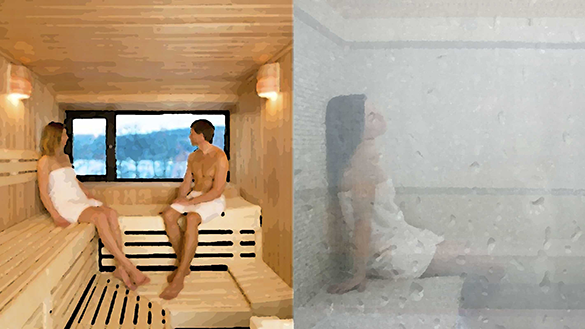What is the difference between a Steam Room and a Sauna?

Steam rooms and saunas are both used for relaxation and health benefits, but they differ in several ways, primarily concerning how they produce heat and humidity.
Here are the key differences:


Heat Source and Temperature:
Saunas: Saunas provide dry heat, often using a stove or heater with stones to elevate the temperature.
Traditional saunas can reach temperatures between 150°F and 195°F (65°C to 90°C).
The high temperatures promote sweating and can be adjusted by controlling air ventilation and adding water to the stones to create bursts of steam and mild humidity.
Steam Rooms: Steam rooms use a generator to produce a moist, warm environment.
They maintain lower temperatures compared to saunas, typically between 110°F and 120°F (43°C to 49°C), but with 100% humidity due to the constant steam being released.
This leads to a different, more humid form of heat.
Humidity:
Saunas: Experience low humidity due to their dry heat, although humidity levels can be temporarily increased by pouring water over heated stones in some sauna types.
Steam Rooms: Characterised by high humidity—up to 100%.
The wet heat can feel much more intense, and some people find it easier on the respiratory system.




Materials and Build:
Saunas: Typically made from wood, saunas are designed to withstand dry, intense heat.
Wooden benches and panels are used to minimise heat conduction and promote a pleasant, rustic aesthetic.
Steam Rooms: Built with impermeable materials like glass, tile, or acrylic to prevent moisture damage.
The design and materials help to contain and manage the wet environment.
Health Benefits:
Both types of saunas may provide similar health benefits, including relaxation, muscle relief, improved circulation, and detoxification through sweating.
However, studies suggest that traditional saunas, using heat and steam, help with pain relief of joints and muscles, improve the respiratory system and cardiovascular health. The intense heat and steam also helps the body produce white blood cells faster, which helps to fight respiratory viruses and allergies.
Steam Rooms: Can increase metabolism which helps weight loss and be better suited for anyone with respiratory health, as the humid air can help to clear congestion and improve sinus function.
As well as promoting better skin hydration due to moisture, the humidity can help if you suffer from asthma or are feeling under the weather.


Saunas might be preferred by those who enjoy dry heat and very high temperatures, whereas steam rooms may appeal to those who benefit more from humid environments and slightly lower heat.
Ultimately, choosing between a steam room and a sauna comes down to individual preferences for heat experience and the specific benefits each delivers.
Both options offer unique aspects that cater to personal preferences, health, tolerance, and different well-being goals.
Materials and build paragraph omage courtesy of: Race
Icon image courtesy of: Netivist





